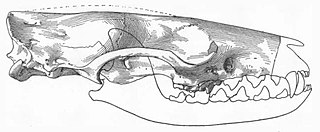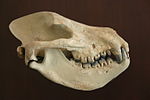
Carettochelyidae is a family of cryptodiran turtles belonging to the Trionychia. It contains only a single living species, the pig-nosed turtle native to New Guinea and Northern Australia. Stem-group carettochelyids are known from the Cretaceous of Asia, with the family being widely distributed across North America, Europe, Asia and Africa during much of the Cenozoic.

Miacis is an extinct genus of placental mammals from clade Carnivoraformes, that lived in North America from the early to middle Eocene.

The John Day Formation is a series of rock strata exposed in the Picture Gorge district of the John Day River basin and elsewhere in north-central Oregon in the United States. The Picture Gorge exposure lies east of the Blue Mountain uplift, which cuts southwest–northeast through the Horse Heaven mining district northeast of Madras. Aside from the Picture Gorge district, which defines the type, the formation is visible on the surface in two other areas: another exposure is in the Warm Springs district west of the uplift, between it and the Cascade Range, and the third is along the south side of the Ochoco Mountains. All three exposures, consisting mainly of tuffaceous sediments and pyroclastic rock rich in silica, lie unconformably between the older rocks of the Clarno Formation below and Columbia River basalts above.

The Fort Union Formation is a geologic unit containing sandstones, shales, and coal beds in Wyoming, Montana, and parts of adjacent states. In the Powder River Basin, it contains important economic deposits of coal, uranium, and coalbed methane.

Procaimanoidea is an extinct genus of alligatorid from the Eocene of North America. It was named posthumously in 1946 by Charles W. Gilmore; the type species is P. utahensis, from the Uintan of Utah. It is based on USNM 15996, a nearly complete skull and partial left hind leg. A second species, P. kayi, was named in 1941 by C.C. Mook as a species of Hassiacosuchus, for remains from the Bridgerian of Wyoming. It was reassigned to Procaimanoidea in 1967 by Wassersug and Hecht.

Vulpavus is an extinct paraphyletic genus of placental mammals from clade Carnivoraformes, that lived in North America from the early to middle Eocene.

Sinopa is an extinct genus of placental mammals from extinct family Sinopidae within extinct order Hyaenodonta, that lived in North America and Asia from the early to middle Eocene.
This paleomammalogy list records new fossil mammal taxa that were described during the year 2012, as well as notes other significant paleomammalogy discoveries and events which occurred during that year.
The Willwood Formation is a sedimentary sequence deposited during the late Paleocene to early Eocene, or Clarkforkian, Wasatchian and Bridgerian in the NALMA classification.
This paleomammalogy list records new fossil mammal taxa that were described during the year 2013, as well as notes other significant paleomammalogy discoveries and events which occurred during that year.

The Ash Hollow Formation of the Ogallala Group is a geological formation found in Nebraska and South Dakota. It preserves fossils dating back to the Neogene period. It was named after Ash Hollow, Nebraska and can be seen in Ash Hollow State Historical Park. Ashfall Fossil Beds State Historical Park is within this formation.

The Wasatch Formation (Tw) is an extensive highly fossiliferous geologic formation stretching across several basins in Idaho, Montana Wyoming, Utah and western Colorado. It preserves fossils dating back to the Early Eocene period. The formation defines the Wasatchian or Lostcabinian, a period of time used within the NALMA classification, but the formation ranges in age from the Clarkforkian to Bridgerian.

The Bridger Formation is a geologic formation in southwestern Wyoming. It preserves fossils dating back to the Bridgerian and Uintan stages of the Paleogene Period. The formation was named by American geologist Ferdinand Vandeveer Hayden for Fort Bridger, which had itself been named for mountain man Jim Bridger. The Bridger Wilderness covers much of the Bridger Formation's area.

The San Jose Formation is an Early Eocene geologic formation in the San Juan Basin of New Mexico and Colorado.

The Uinta Formation is a geologic formation in northeastern Utah. The name appears on a geologic map accompanying the Clarence King Fortieth Parallel report for 1876 but not defined until 1878 as the Uinta Group. As defined, it consisted of all Tertiary strata overlying the Green River Formation and was composed of coarse, conglomeratic sandstones, passing up into finer-grained sandstones and calcareous mudstones. Numerous vertebrate fossils were collected and described by Othniel C. Marsh of Yale University. The formation was subsequently subdivided into three informal horizons based on mammalian fossils. Horace Wood proposed the name Wagonhound Member for Uinta A+B and Myton Member for Uinta C. However, these names are not based on lithology, but on mammalian vertebrate faunas. For that reason, they have not been accepted as proper lithostratigraphic names.
The Sheep Pass Formation is a geologic formation in Nevada. It preserves fossils dating back to the Paleogene period.
This paleomammalogy list records new fossil mammal taxa that were described during the year 2011, as well as notes other significant paleomammalogy discoveries and events which occurred during that year.

Viverravus is an extinct genus of placental mammals from extinct subfamily Viverravinae within extinct family Viverravidae, that lived in North America, Europe and Asia from the middle Paleocene to middle Eocene.
Wyonycteris is a genus of small mammals that existed in the late Paleocene and early Eocene epochs. The type species is Wyonycteris chalix, which lived in Wyoming during the Clarkforkian North American Land Mammal Age of the Paleocene and was originally proposed to be an early form of insectivorous bat. Later re-examination of the material has put this alliance in doubt, and the genus has instead been proposed as belonging to the subfamily Placentidentinae, within the family Nyctitheriidae. Similar fossil material of the same time period found in Europe was later discovered and described as new species, Wyonycteris richardi.

Achaenodon is an extinct artiodactyl mammal, possibly belonging to the family Helohyidae. It lived in the mid-late Eocene and its fossil remains have been found in North America.
































